
Shigeru Miyamoto is a Japanese video game designer, producer and game director at Nintendo, where he serves as one of its representative directors as an executive since 2002. Widely regarded as one of the most accomplished and influential designers in video games, he is the creator of some of the most acclaimed and best-selling game franchises of all time, including Mario,The Legend of Zelda, Donkey Kong, Star Fox and Pikmin. More than 1 billion copies of games featuring franchises created by Miyamoto have been sold.

A game controller, gaming controller, or simply controller, is an input device or input/output device used with video games or entertainment systems to provide input to a video game. Input devices that have been classified as game controllers include keyboards, mice, gamepads, and joysticks, as well as special purpose devices, such as steering wheels for driving games and light guns for shooting games. Controllers designs have evolved to include directional pads, multiple buttons, analog sticks, joysticks, motion detection, touch screens and a plethora of other features.

The Wii is a home video game console developed and marketed by Nintendo. It was released on November 19, 2006 in North America, and in December 2006 for most other regions of the world. It is Nintendo's fifth major home game console, following the GameCube and is a seventh-generation console alongside Microsoft's Xbox 360 and Sony's PlayStation 3.
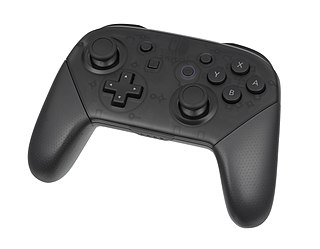
A gamepad is a type of video game controller held in two hands, where the fingers are used to provide input. They are typically the main input device for video game consoles.
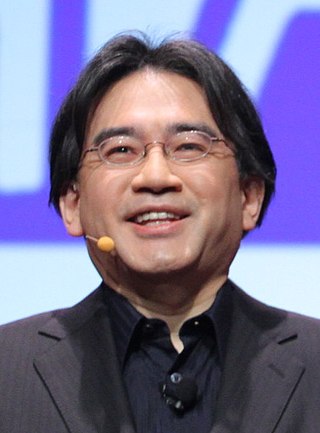
Satoru Iwata was a Japanese businessman, video game programmer, video game designer, and producer. He was the fourth president and chief executive officer (CEO) of Nintendo from 2002 until his death in 2015. He was a major contributor in broadening the appeal of video games by focusing on novel and entertaining games rather than top-of-the-line hardware.
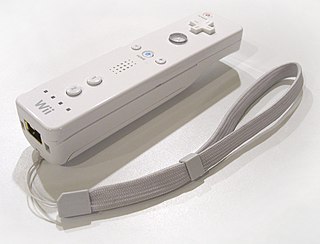
The Wii Remote, also known colloquially as the Wiimote, is the primary game controller for Nintendo's Wii home video game console. An essential capability of the Wii Remote is its motion sensing capability, which allows the user to interact with and manipulate items on screen via motion sensing, gesture recognition, and pointing using an accelerometer and optical sensor technology. It is expandable by adding attachments. The attachment bundled with the Wii console is the Nunchuk, which complements the Wii Remote by providing functions similar to those in gamepad controllers. Some other attachments include the Classic Controller, Wii Zapper, and the Wii Wheel, which was originally released with the racing game, Mario Kart Wii.

The Classic Controller is a game controller produced by Nintendo for the Wii home video game console. While it later featured some compatibility with the Wii U console, the controller was ultimately succeeded by the Wii U Pro Controller. In April 2014, Nintendo discontinued production of both the Classic Controller and Classic Controller Pro.

A Mii is a customizable avatar used on several Nintendo video game consoles and mobile apps. The name Mii is a portmanteau of "Wii" and "me", referring to them typically being avatars of the players. Miis were first introduced on the Wii console in 2006 and later appeared on the DS, 3DS, the Wii U, the Switch, and various apps for smart devices such as Miitomo. Miis can be created using different body, facial and clothing features, and can then be used as characters within games on the consoles, either as an avatar of a specific player or in some games portrayed as characters with their own personalities. Miis can be shared and transferred between consoles, either manually or automatically with other users over the internet and local wireless communications.

The GameCube controller is the standard game controller for the GameCube home video game console, manufactured by Nintendo and launched in 2001. As the successor to the Nintendo 64 controller, it is the progression of Nintendo's controller design in numerous ways. The contentious M-shaped design of its predecessor was replaced with a more conventional handlebar style controller shape; a second analog stick was added, replacing the C buttons with a C stick and the X and Y face buttons, last seen on the Super Nintendo controller, were reintroduced; the shoulder buttons were changed to hybrid analog triggers. A wireless variant of the GameCube controller known as the WaveBird was released in 2002.

The Japanese multinational consumer electronics company Nintendo has developed seven home video game consoles and multiple portable consoles for use with external media, as well as dedicated consoles and other hardware for their consoles. As of September 30, 2021, in addition to Nintendo Switch, Nintendo has sold over 863.07 million hardware units.
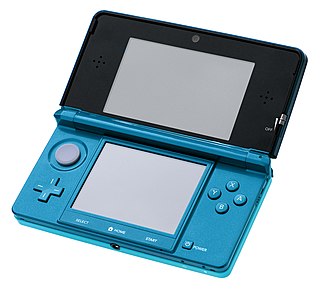
The Nintendo 3DS is a foldable handheld game console produced by Nintendo. The console was announced in March 2010 and unveiled at E3 2010 as the successor to the Nintendo DS. The system features backward compatibility with Nintendo DS video games. As an eighth-generation console, its primary competitor was Sony's PlayStation Vita.
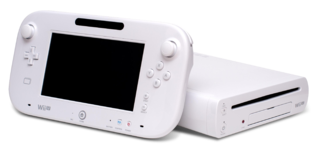
The Wii U is a home video game console developed by Nintendo as the successor to the Wii. Released in late 2012, it is the first eighth-generation video game console and competed with Microsoft's Xbox One and Sony's PlayStation 4.
The Nintendo Network is a defunct online service formerly ran by Nintendo that provided free online functionality for the Nintendo 3DS and Wii U systems and their compatible games. Announced on January 26, 2012, at an investors' conference, it was Nintendo's second online service after Nintendo Wi-Fi Connection. Former president of Nintendo Satoru Iwata said, "Unlike Nintendo Wi-Fi Connection, which has been focused upon specific functionalities and concepts, we are aiming to establish a platform where various services available through the network for our consumers shall be connected via Nintendo Network service so that the company can make comprehensive proposals to consumers."

Nintendo Land is a party video game developed and published by Nintendo as a pack-in launch title for the Wii U home video game console in 2012. The game was first announced at E3 2012 during Nintendo's press conference.

Game & Wario is a 2013 party video game developed by Nintendo and Intelligent Systems and published for the Wii U console, named after LCD Game & Watch titles. It is the eighth installment in the WarioWare series and part of the larger Mario franchise. The story stars Wario and his friends, who take advantage of a newly released video game console with two separate screens by making games for monetary gain. Game & Wario consists of 16 minigames that exclusively utilize the Wii U GamePad and its functions. Additional modes and collectibles are also unlockable. The majority of the minigames are single-player, although some are designed for multiplayer only.

The Wii U Pro Controller is a video game controller produced by Nintendo for the Wii U video game console. It is available in Black and White. It is the successor to the Wii Classic Controller and has the same buttons but with the added features of a power button, and pressable analog sticks. In 2013, a year since the Wii U's release, a hacking website Hackaday found a way to use a Wii U Pro Controller and Wii U GamePad on PC.

Off-TV Play is a feature of Nintendo's eighth-generation video game console, the Wii U. Like all video game consoles, the Wii U uses a console and a controller to manipulate an image on a television screen. The Wii U's unique feature is that its controller, the Wii U GamePad, has its own built-in screen for displaying images. It can display an entirely different image, or duplicate the television screen into the Wii U GamePad. Off-TV Play is the term used for when an entire game is played strictly on the controller, without the use of a television. The GamePad also features two speakers that can be used for Off-TV Play. There is no standardized way to activate Off-TV Play and how it's implemented depends on the game.

The Nintendo 2DS is a handheld game console produced by Nintendo. Announced in August 2013, the device was released in North America, Europe and Australia on October 12, 2013. The Nintendo 2DS is an entry-level version of the Nintendo 3DS which maintains otherwise identical hardware, similar functionality, and compatibility with software designed for the Nintendo DS and 3DS. However, the 2DS is differentiated by a new slate form factor rather than the clamshell design used by its precursors and by lacking the Nintendo 3DS's signature autostereoscopic 3D display. The 2DS was sold concurrently with existing 3DS models as an incentive to expand the market for Nintendo 3DS games; former Nintendo of America president Reggie Fils-Aimé stated that the 2DS was primarily targeted towards younger players, whom Nintendo had previously advised not to use the 3D functionality on the 3DS due to potential eye health concerns. The Nintendo 2DS's successor, the New Nintendo 2DS XL, was launched in 2017.

The Nintendo Switch is a video game console developed by Nintendo and released worldwide in most regions on March 3, 2017. Released in the middle of the eighth generation of home consoles, the Switch succeeded the Wii U and competed with Microsoft's Xbox One and Sony's PlayStation 4; it also competes with the ninth-generation consoles, Microsoft's Xbox Series X/S and Sony's PlayStation 5.




















